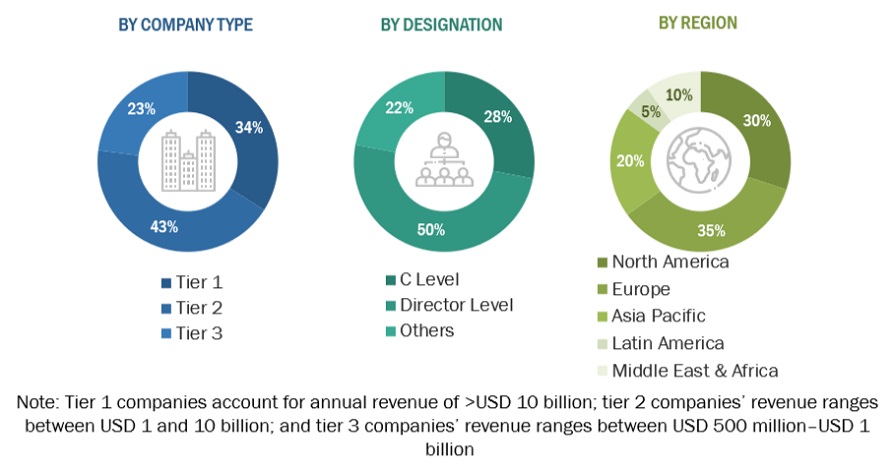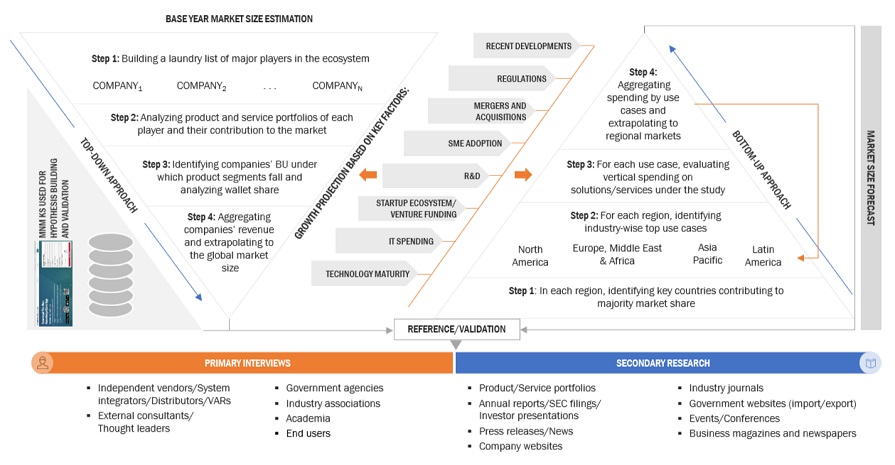The Analytics as a Service market research study involved extensive secondary sources, directories, journals, and paid databases. Primary sources were mainly industry experts from the core and related industries, preferred AaaS providers, third-party service providers, consulting service providers, end users, and other commercial enterprises. In-depth interviews were conducted with various primary respondents, including key industry participants and subject matter experts, to obtain and verify critical qualitative and quantitative information, and assess the market’s prospects.
Secondary Research
In the secondary research process, various sources were referred to, for identifying and collecting information for this study. Secondary sources included annual reports, press releases, and investor presentations of companies; white papers, journals, and certified publications; and articles from recognized authors, directories, and databases. The data was also collected from other secondary sources, such as journals, government websites, blogs, and vendors' websites. Additionally, AaaS spending of various countries was extracted from the respective sources. Secondary research was mainly used to obtain key information related to the industry’s value chain and supply chain to identify key players based on software, services, market classification, and segmentation according to offerings of major players, industry trends related to software, services, cloud type, data type, data processing, analytics type, vertical and regions, and key developments from both market- and technology-oriented perspectives.
Primary Research
In the primary research process, various primary sources from both the supply and demand sides were interviewed to obtain qualitative and quantitative information on the market. The primary sources from the supply side included various industry experts, including Chief Experience Officers (CXOs); Vice Presidents (VPs); directors from business development, marketing, and AaaS expertise; related key executives from AaaS software vendors, SIs, professional service providers, and industry associations; and key opinion leaders.
Primary interviews were conducted to gather insights, such as market statistics, revenue data collected from software and services, market breakups, market size estimations, market forecasts, and data triangulation. Primary research also helped understand various trends related to technologies, applications, deployments, and regions. Stakeholders from the demand side, such as Chief Information Officers (CIOs), Chief Technology Officers (CTOs), Chief Strategy Officers (CSOs), and end users using AaaS software, were interviewed to understand the buyer’s perspective on suppliers, products, service providers, and their current usage of AaaS software and services, which would impact the overall Analytics as a Service market.
The Breakup of Primary Research:

To know about the assumptions considered for the study, download the pdf brochure
Market Size Estimation
In the bottom-up approach, the adoption rate of AaaS among different end users in key countries concerning their regions contributing the most to the market share was identified. For cross-validation, the adoption of AaaS software and services among industries and different use cases concerning their regions was identified and extrapolated. Weightage was given to use cases identified in different regions for the market size calculation.
Based on the market numbers, the regional split was determined by primary and secondary sources. The procedure included the analysis of the AaaS market’s regional penetration. Based on secondary research, the regional spending on Information and Communications Technology (ICT), socio-economic analysis of each country, strategic vendor analysis of major AaaS providers, and organic and inorganic business development activities of regional and global players were estimated. With the data triangulation procedure and data validation through primaries, the exact values of the overall AaaS market size and segments’ size were determined and confirmed using the study.
Global Analytics as a Service Market Size: Bottom-Up and Top-Down Approach:

To know about the assumptions considered for the study, Request for Free Sample Report
Data Triangulation
Based on the market numbers, the regional split was determined by primary and secondary sources. The procedure included the analysis of the Analytics as a Service market’s regional penetration. Based on secondary research, the regional spending on Information and Communications Technology (ICT), socio-economic analysis of each country, strategic vendor analysis of major AaaS providers, and organic and inorganic business development activities of regional and global players were estimated. With the data triangulation procedure and data validation through primaries, the exact values of the overall Analytics as a Service market size and segments’ size were determined and confirmed using the study.
Market Definition
Analytics as a Service (AaaS) is a type of Cloud service. It provides access to data analysis software and tools through the Cloud, rather than having to invest in on-premise software. AaaS services are complete and customizable solutions for organizing, analyzing and visualizing data. The objectives are the same as for on-premise solutions, namely, to provide information that can be used to make better decisions. These tools offer different data analysis methods and technologies such as Data Mining, Predictive Analysis, Dataviz or even advanced techniques such as Artificial Intelligence and Machine Learning. One of the main advantages of AaaS solutions is that these services are based on a subscription model. As with other types of Cloud services, the user pays only for the resources he or she consumes. This typically saves money compared to purchasing on-premise software and the accompanying license.
Stakeholders
-
Application design and software developers
-
Business owners/executives
-
Service managers
-
Cloud service providers
-
Consulting service providers
-
Data scientists
-
Quality assurance analysts
-
Distributors and Value-added Resellers (VARs)
-
Government agencies
-
Independent Software Vendors (ISVs)
-
Market research and consulting firms
-
Support and maintenance service providers
-
System Integrators (SIs)/Migration service providers
-
Technology providers
-
Analytics Service Providers
-
Chief Data Officers (CDOs)
-
Academic and Research Institutions
Report Objectives
-
To define, describe, and predict the Analytics as a Service market by offering (software (type, integration) and services), data type, data processing, analytics type, vertical, and region
-
To provide detailed information related to major factors (drivers, restraints, opportunities, and industry-specific challenges) influencing the market growth
-
To analyze the micro markets with respect to individual growth trends, prospects, and their contribution to the total market
-
To analyze the opportunities in the market for stakeholders by identifying the high-growth segments of the Analytics as a Service market
-
To analyze the opportunities in the market and provide details of the competitive landscape for stakeholders and market leaders
-
To forecast the market size of segments for five main regions: North America, Europe, Asia Pacific, Middle East & Africa, and Latin America
-
To profile key players and comprehensively analyze their market rankings and core competencies.
-
To analyze the competitive developments, such as partnerships, product launches, and mergers & acquisitions, in the Analytics as a Service market
-
To analyze the impact of recession across all regions in the Analytics as a Service market
Available Customizations
With the given market data, MarketsandMarkets offers customizations as per your company’s specific needs. The following customization options are available for the report:
Product Analysis
-
Product quadrant, which gives a detailed comparison of the product portfolio of each company.
Geographic Analysis
-
Further breakup of the North American Analytics as a Service market
-
Further breakup of the European Analytics as a Service market
-
Further breakup of the Asia Pacific Analytics as a Service market
-
Further breakup of the Middle Eastern & African Analytics as a Service market
-
Further breakup of the Latin America Analytics as a Service market
Company Information
-
Detailed analysis and profiling of additional market players (up to five)



Growth opportunities and latent adjacency in Analytics as a Service Market